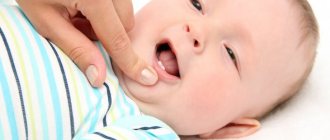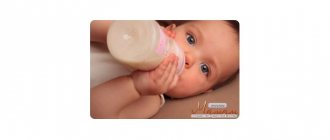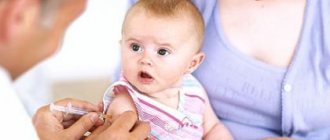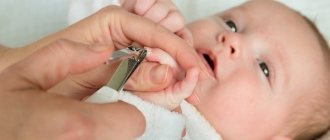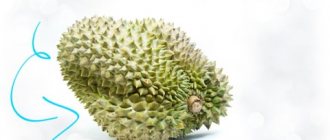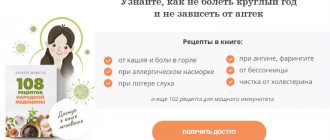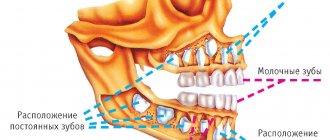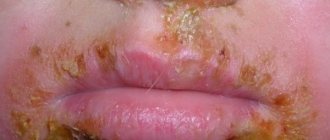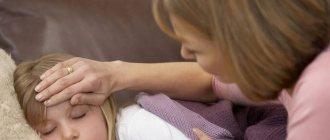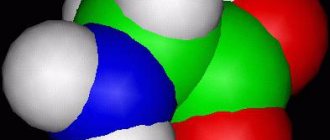Is it normal for a baby to have a fever during teething?
The hassles associated with the birth of a child are always numerous and not always pleasant in some cases. If a baby gets sick, and this can happen at any age, parents sound the alarm and look for a way to help him.
But it also happens that malaise is not a manifestation of a disease, but a consequence of a natural process in the body. For example, teething.
Pain, redness and swelling of the gums are not everything. Temperature – it scares parents in every case, so it’s worth dealing with this phenomenon.
It should be understood that an increase in the temperature threshold is a consequence of deep changes
. To break through, a tooth has to overcome the resistance of several layers of tissue. First it is the bone tissue of the jaw, and then the gum itself.
The tissues perceive it as a foreign body, give a signal to the immune system and the number of leukocytes in the blood increases. That is, inflammation occurs
. Immunity decreases, and the body directs all its forces to secrete antibodies to fight the “enemy”.
The temperature is at 37-37.5 and there is a signal that the production of antibodies has begun. It is not harmful to the child, but rather necessary. There is absolutely no need to reduce the fever if the upper limit is not higher than 38 degrees
. It will drop to normal levels on its own when the body gives a signal that the internal struggle has been successful.
How to tell if your baby is teething
The first teeth erupt at the age of 4–8 months. But the timing of teething, as well as the behavior of infants during this period, may differ. The features of the process are partly influenced by genetics. To find out whether your child will experience painful teething, it is worth asking his grandparents about how things were with their children.
Newborns already have the rudiments of baby teeth. They are just waiting in the wings to erupt.
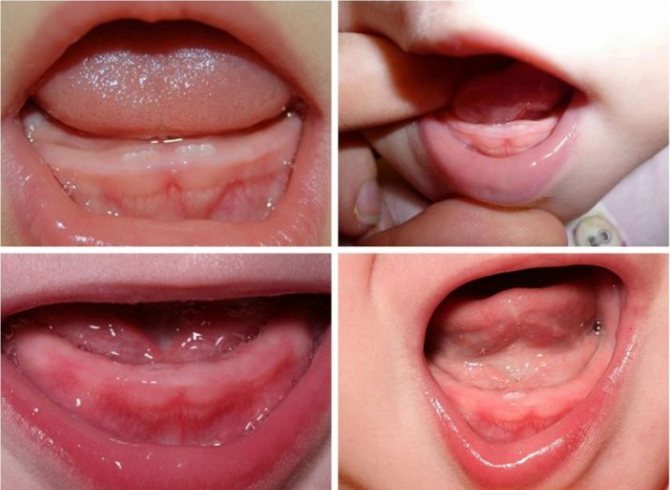
When the first baby tooth appears, a newborn experiences a whole range of symptoms. But restless behavior and capriciousness are not always the result of this painful phenomenon. It is worth taking a closer look at the child’s behavior. The following signs indicate that his teeth will come out soon:
- the child behaves restlessly more often than usual;
- the baby often cries and sleeps poorly;
- his gums become swollen and red;
- the baby's temperature rises;
- the baby puts into his mouth all objects that come to hand;
- he produces a large amount of saliva;
- the baby often wakes up in the middle of the night;
- he has poor appetite;
- the child touches his ears and face with his hands;
- due to excessive saliva production, the child begins to cough;
- Hematomas form on his gums.
Additional symptoms
Temperature may be accompanied by several other important signs of teething, such as:
- Increased salivation; Loose stools; Swollen gums; Runny nose; Cough; Redness of the cheeks and neck; Enlarged lymph nodes.
It is necessary to look at each of these symptoms individually to understand how they relate to teething. It is worth knowing how some manifestations are associated with risks, and how to recognize a moment of danger.
Saliva
is a natural antiseptic; its release helps prevent infection from entering tissues and developing more serious consequences. Violation of the integrity of the gums by the emerging tooth is disinfected by saliva, and tissue regeneration occurs faster.
Runny nose
occurs due to the proliferation of pathogenic bacteria in the nasopharynx cavity, as immunity decreases. The respiratory organs also become inflamed and try to fight off the infection. Lymph nodes enlarge as with any infectious disease, when the body's defenses work harder.
Bacteria also spread to the gastrointestinal system, so stool problems in the form of diarrhea
. Frequent swallowing of saliva is also a common cause of diarrhea.
Two or three times in a row is already the beginning of dehydration of the body, it’s time to take emergency measures to take medications against dysbiosis.
Want to know how children's teeth grow? Read our article and see photos.
Let's find out how to cure tonsillitis in a child at home.
Cough
may be rare, with pharyngeal contents being rejected. Saliva is swallowed and irritates the throat, so the nature of the cough is specific - hysterical. It also happens that a cough provokes a gag reflex. If you have a frequent cough, you should examine your child for acute respiratory infections.
With any inflammation, blood flows to the sites where leukocytes fight infection. This causes redness of the skin in the gum area
. In addition, the child often rubs and touches these places, exacerbating their redness. Red and swollen gums are a sign of inflammation in the mouth.
What else mothers should know about teething in their children - watch the video:
Under one year of age
The most problematic thing is teething in infants. Children under one year of age react most acutely to any ailment, becoming restless or lethargic. The risks of not noticing the moment when the norm turns into pathology are very high
.
The most common symptom of teething in a baby is an increase in body temperature. There are practically no standard indicators here - it can range from 37 to 39 degrees.
But still, the so-called low-grade temperature is up to 37.5 degrees. Normally, this condition lasts 1-3 days. But still, there are some peculiarities here, in accordance with which recommendations are given:
- If the temperature rises above 37.5, or lasts more than 2-3 days, you should contact your pediatrician; As a rule, pain in the gums prevents the child from sleeping at night. Therefore, creating a gentle daily routine and not limiting daytime sleep is a strict rule for parents; Reducing the temperature to 38 degrees is not only pointless, but also harmful. It is also an indicator of the child’s condition, making it easier to track him; External behavior is an important indicator. When a child cries and worries, his condition is better than in the case of a passive reaction and weak reaction to the environment.
A temperature that is too high (more than 38-38.5) signals the onset of a serious inflammatory process or the penetration of an infection into the body. It can also cause neurological disorders and is dangerous for cardiac function.
Pain relieving gels for teething
| Kalgel |
|
| Holisal |
|
| Dentinox |
|
| Dentol – baby 7.5% |
|
| Kamistad |
|
Kalgel
The product is effective, but it is recommended to use it only after the recommendation of a pediatrician. Due to the fact that the drug contains lidocaine hydrochloride, allergic reactions in the form of rash and itching, as well as anaphylactic shock, are possible. The drug is prohibited for children with renal failure, as it is excreted through the kidneys in the urine. Contraindicated for use in children with heart and stomach diseases (if intraventricular conduction is impaired).
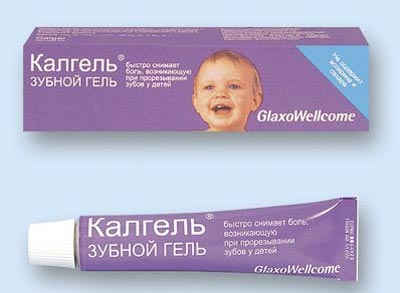
Dosage regimen: interval of at least 20 minutes between doses, and no more than 6 times a day. Apply 7.5 mm of gel to the tip of a clean finger and gently rub into the inflamed and swollen area of the gum.
Holisal
In addition to the fact that the drug eliminates pain and fights germs and viruses in the oral cavity, it also relieves swelling. The advantage is its antipyretic effect, which begins quite quickly - after 2-3 minutes. Effectiveness from 2 to 8 hours.
Apply 0.5 cm of gel from the tube onto a clean finger and rub into the area of the inflamed gum. Some parents apply the product to the pacifier, which is strictly prohibited. The product is not absorbed properly by the gums, and when swallowed it enters the gastrointestinal tract.
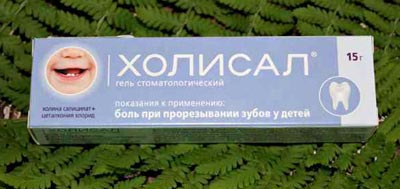
Judging by the reviews, this drug helps a lot, although it is not recommended for children under 1 year of age. Lidocaine can cause allergies, so there is no need to self-medicate. Before use, be sure to consult your doctor.
Dentinox
Not only does it help get rid of aching pain and discomfort, but it is also a preventive measure: it prevents the appearance of swelling and inflammatory processes, and irritation in the oral cavity. It has a pleasant sweetish taste and is not immediately washed off with saliva.
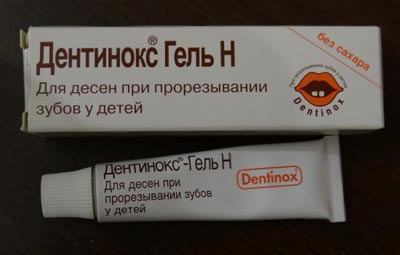
Apply the gel after eating and before bed. There are no special contraindications, but at one time you can rub a very small amount into the inflamed area of the gum - no more than a pea.
Dentol baby, 7.5%
The drug does not contain dangerous lidocaine and can be used from the age of four months. Quickly relieves pain and inflammation. The main disadvantage is considered to be a short-term effect.
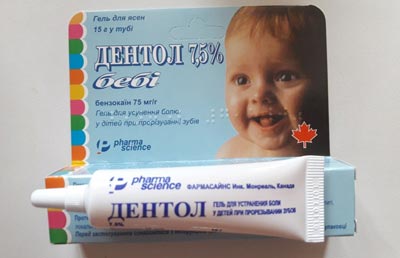
Good value for money. Apply to the fingertip in a layer of no more than 0.5-1 cm. Then carefully rub it first into the upper gum, then into the lower gum. The taste is pleasant because it contains cherry flavor and ascorbic acid.
Kamistad
The main ingredients included in the composition are lidocaine and chamomile extract. Use with caution in children under one year of age. Chamomile extract, as well as honey and mint flavoring, make the tan gel quite pleasant to the taste.
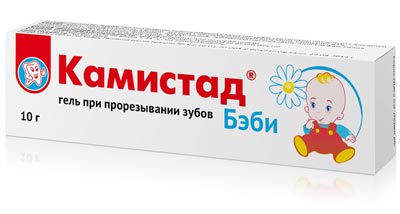
Apply the product to your finger or a cotton swab and rub into the gums. Can be used no more than 2-3 times a day. Recommended to use after meals and before bed.
At the age of 1-2 years
If the parents of a baby are just faced with the problem of teething, then at one or two years of age the situation is a little easier and is already familiar to many.
However, the temperature can also rise and cause a lot of trouble. The reasons for its occurrence and what adults need to know - it’s worth getting to know this in more detail.
The specificity of this age is such that the Child begins to intensively “catch” various types of infections
. The peak incidence of acute respiratory viral infections and acute respiratory infections occurs in the first years of life.
At the same time, milk teeth appear, which did not have time to erupt until they were a year old.
If a high temperature occurs, the child should be completely excluded from becoming ill.
. Paying attention to other symptoms and making sure to call a doctor at home is a way to prevent the development of a serious complication.
If the thermometer shows above 39
It is not typical for a child of any age to have an abnormally high temperature. Moreover, its rise is above 39 degrees. The reasons for this may be the following:
A weakened immune system allowed the virus to enter the body. The eruption of molars or premolars occurs - these teeth appear the most difficult. A serious inflammatory process develops that requires medical intervention.
This temperature requires an immediate medical visit to the child. It is fraught with the risk of knocking it down too intensely, in order to avoid the impossibility of controlling the condition.
But a child’s prolonged exposure to a fever can lead to convulsions and disruptions in the functioning of many organs and systems.
How and in what cases can it be knocked down?
Sometimes the temperature can be lowered without harming the child's condition. Even a short decrease in blood pressure brings relief, and the baby can sleep or eat. Such cases are listed below.
Some children begin to cut teeth earlier than the generally accepted period - at 2 or 3 months. The body is not yet ready for such stress and it is necessary to bring down the temperature as soon as it reaches 38 degrees
.
But, just like a sudden increase, a sharp decrease in it is not recommended by doctors. First, the readings can be lowered by 1-2 degrees, and then gradually returned to the limits of subfebrile temperature.
Healthy children, unlike children with poor health, including those with birth injuries, can tolerate high temperatures better and a little longer. This should also be taken into account, but based on the specifics of each specific situation.
You can bring down the temperature with medication or physical methods. The parents determine what type of method to use on their own, based on the child’s condition.
Physical methods are more gentle, so it’s worth starting with them.
Rubdown
- the most common and effective method. Moisten a cloth in cool (36-37°) water and wipe the child’s entire body every 2 hours. After the procedure, they wrap him in a warm blanket.
Ibuprofen and paracetamol have proven themselves to be effective as medicinal methods.
. These can be either candles or syrup.
Children's "Paracetamol", "Nurofen" from 3 months, antipyretic suppositories
– the choice is great. When choosing a dosage form and dosage, you again need to focus on the child’s age, weight and drug tolerance.
Why might a white coating appear on the tongue of a newborn? There are several reasons for this.
We will tell you about the most effective methods of treating candidal stomatitis.
If it does not decrease for a long time
If the temperature is high, when methods of reducing it at home are used, urgent measures need to be taken. Calling an ambulance is the best way out of the situation
.
Before the team arrives, parents can alleviate the child’s condition and prevent it from worsening. Their actions may be as follows:
- Give the child plenty of warm drinks; Remove excess clothing from him for free heat exchange in the body; Ventilate the room, but without a draft, and if there are radiators, also moisturize; Raise the head of the bed so that the blood flow to the head decreases.
The fact that the methods used are ineffective and the temperature does not decrease can only be said an hour after the procedure. After one hour, you can call an ambulance.
Is it possible to walk while doing this?
Parents are often interested in what kind of lifestyle can be led during teething. If the child shows almost no anxiety and tolerates this period calmly, then the daily routine can be normal.
With the exception of sleep, you need to rest more. Temperature makes its own adjustments to all activities with the baby. This also applies to walking.
Experts agree that walking is only possible at average temperatures. At values of 38 and above, you should refrain from walking, especially in the cold season
.
To summarize what has been said, it is worth recalling that an increase in temperature in children during teething is normal.
Parents should monitor changes in its meanings and manifestations of the child’s condition on their own. In accordance with this, make adjustments to your daily routine, and if medical intervention is necessary, consult a doctor.
The age of the child and high temperature during teething are interrelated phenomena; this should be taken into account when using certain methods of helping him.
What Dr. Komarovsky says about a child’s temperature during teething - watch the video:
When it is not necessary and you need to lower the temperature
Parents need to know the correct tactics for monitoring their child and the algorithm for reducing the temperature reaction during teething in children, and for this they need to understand how long the period of normal temperature rise lasts.
When the temperature rises in a young child, first of all, it is necessary to determine why the baby has a temperature reaction - consult a pediatrician on the first day of the appearance of this symptom.
After the examination, the specialist will determine the reason for its increase, the need to take medications, and routine issues (is it possible to bathe the baby and walk in the fresh air).
After the diagnosis of “teething syndrome” has been clarified, constant monitoring of the child and temperature control is necessary.
In most cases, an increase in temperature in the range of 37.3 - 37.7 ° C is considered normal during teething - and there is no need to reduce it with medications. Low-grade fever during teething can normally last no more than 3 days, then you need to consult a pediatrician again.
Additionally you need to create:
- a calm, friendly environment;
- good nutrition - breast milk or an adapted milk formula that the baby consumed previously;
- drinking regime, if necessary, give special children's tea, boiled water;
- conditions for proper sleep and rest for the child;
- constant ventilation of the room in which the baby is located and creating a comfortable microclimate in the room (air temperature, humidity);
- remove all restrictive objects that interfere with normal heat exchange - synthetic clothing, diapers;
- Constant monitoring of temperature so as not to miss its rise to high numbers and bring it down with physical methods and/or antipyretics (Nurofen or Efferalgan in syrup or suppositories) if necessary.
Taking antipyretic medications to reduce fever during teething syndrome is necessary:
- when the temperature rises above 38.5 -39 ° C;
- if there is a history of convulsions or if the baby has a disease of the lungs, heart and central nervous system - the temperature drops when it rises to 38-38.5 ° C and/or at any number if the child’s well-being is significantly impaired;
- if convulsions occur, the temperature must be reduced even at 37.5.
We invite you to familiarize yourself with periodontal disease treatment at home forum
In pediatrics, only two active medicinal components of antipyretics are approved for use - paracetamol and ibuprofen (Nurofen, Ibufen, Panadol, Efferalgan, Cefekon - D).
Before using any drug, you must read the instructions, use only drugs in the pediatric form (syrups, suspensions, rectal suppositories), not exceeding the single and daily dose and frequency of administration.
How long can fever last on teeth?
The baby's first teeth erupt at about 4-5 months. In many cases (more than 50%), the process is accompanied by an increase in temperature. The discomfort is especially obvious when the fangs come out. They have very deep roots, running close to the facial nerve. Parents definitely need to find out how many days the temperature lasts during teething, so that they can show the child to the pediatrician in time if the process drags on.
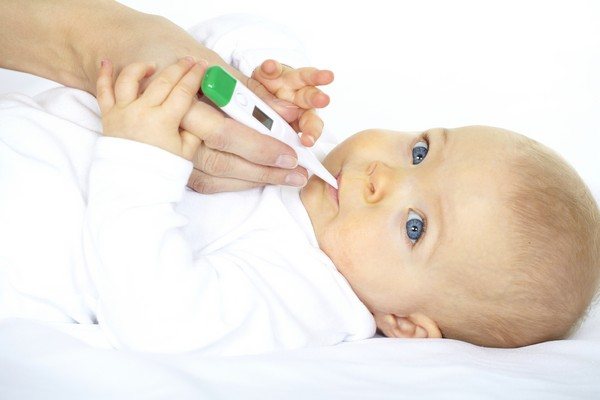
When teeth are cut, the baby loses appetite and sleep is disturbed. The following symptoms gradually appear:
- general weakness; temperature 38-39° (approximately), which lasts several days; increased salivation; rash on the face; bowel dysfunction (diarrhea, bloating, regurgitation); redness of the gums; rhinitis (runny nose).
It happens that the baby puts a finger or fist in his mouth when his teeth come out to scratch his gums. Parents can help the baby using contact, drug therapy and traditional medicine. It is advisable to entrust the selection of medications to a pediatrician.
High fever during teething in children is the most obvious symptom. It occurs in every second child due to the onset of inflammation in the gums. In the place where teeth should erupt, active substances accumulate, negatively affecting the child’s immune system. Weakened immunity is the reason why the temperature rises when teeth are cut. Because of it, an infection can enter the body. In infants, this is manifested by cold symptoms and bowel dysfunction (often pooping liquid feces).
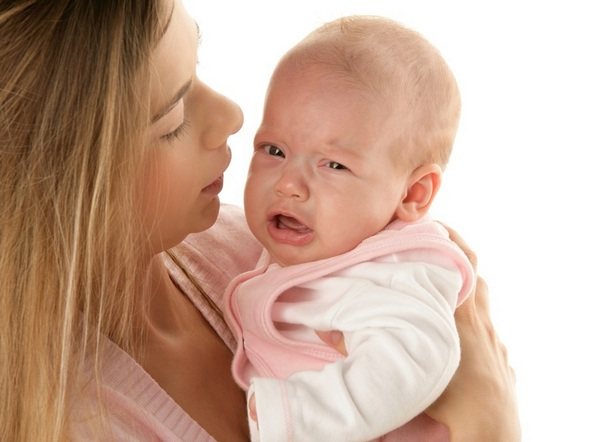
Is coughing a symptom of teething?
To understand whether it relates to the appearance of teeth or the reason is completely different, observe the frequency of coughing attacks and its manifestations. Especially young parents may well mistake the signs of a cold in their baby for the beginning of teething.
- Cough, runny nose and high temperature indicate a weakening of the protective functions of the child’s immune system. During this period, the baby’s body is most accessible to infections and viruses.
- A teething cough can be considered natural when irritation appears around the child’s mouth (on the chin and cheeks) in the form of a small rash when coughing. This indicates that phlegm comes out along with saliva. And the cough itself appears in the form of small attacks for just a few minutes.
- At night, it can last up to 5 minutes, since the child is in a horizontal position, and sputum accumulates in the bronchi.
- It happens that the development of a cough begins from drying out of the mucous membrane in the larynx with frequent crying. Usually the cough goes away after a few days, as soon as the baby feels better.
- If the baby shows signs such as shortness of breath, wheezing or a dry cough, and the attacks are prolonged, then most likely this is a concomitant cold.
What medications can be given to a baby for cough?
The most important thing to always remember is that self-medication is unacceptable. After all, an advanced disease can have complications and further worsen the baby’s well-being. Use certain medications only after consulting your doctor. Even if this is not your first child, still keep in mind that each person, especially a small one, has their own characteristics and individual reaction to any medications.
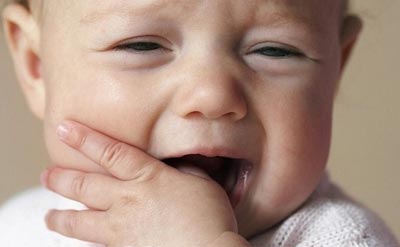
If the cough really concerns teething, then, first of all, all efforts should be directed to facilitating the process of teething. And short-term coughing attacks are an accompanying symptom.
- Cough during teething in infants does not require special treatment. At this age, the most important thing is the mother who is nearby, her affection and care. You will have to be patient and find ways to stop the baby from crying. Try to stop the onset of irritation or anxiety in a timely manner. Show imagination and resourcefulness to distract your baby from pain.
- You can really help your baby if you regularly clear mucus buildup from your baby's nose using a nasal aspirator or bulb.
- It is recommended to wash with a saline solution or drops based on sea water (“Aquamaris”). Do the procedure 3-4 times a day for severe runny nose and cough.
- Avoid using table salt, as recent research suggests it contains chemical additives that are used to maintain presentation and prevent stickiness. An alternative is Himalayan pink salt.
- Rinsing with chamomile will preserve the natural microflora in the baby’s nasopharyngeal mucosa and reduce swelling.
- Mucolytic agents that help thin sputum and remove it will not bring any results up to 3 years of age. Children under this age cannot expectorate mucus.
How long does it last?
Inexperienced parents should consult a pediatrician about how long a child's fever can last during teething. The specialist will explain all the details of the process and tell you whether it needs to be knocked down and what to do for this. If everything is normal, then the child’s temperature may rise for 2-3 days.
When molars are cut, especially if 2 at once, it increases for 5 or more days. It is advisable to show the child to a pediatrician in order to prevent the development of complications. It happens that the dental temperature rises only for a couple of hours. It all depends on the individual characteristics of the baby.
Help with high fever
When teething in children, a symptom such as fever must be stopped. It is recommended to find out its exact source in order to select the appropriate treatment. To begin with, you can ventilate the room where the child is, give him water and undress, since the temperature may be due to simple overheating. The manipulations performed will reduce it and alleviate the condition of the baby.
The course of therapy also depends on how long the temperature lasts during teething. Due to decreased immunity, infection can enter the body. How much the temperature rises is determined by the type and severity of the pathological process that has arisen.
If it does not subside for more than 3 days, the child should be shown to a doctor.
An increase in temperature during teething is combined with stool disturbances. The baby constantly swallows saliva due to its increased secretion. Diarrhea gradually develops. The stool becomes watery and odorless. Normal functioning of the gastrointestinal tract will be restored on its own when the body stops cutting teeth. If blood clots are found in the stool, the baby should be examined. This symptom is not characteristic of teething. He talks about the development of other pathologies in the body.
Drug treatment
If the temperature rises during teething, then it is necessary to use medications to reduce it. A detailed list of funds is located below:
- Paracetamol is a group of anilipids and is used as an antipyretic drug, as well as to reduce inflammation and relieve pain. After administration, the effect occurs within half an hour. If the baby is teething and the temperature is 39 ° or higher, then the drug will only slightly alleviate the condition. "Efferalgan" shows good results when the child's temperature does not exceed 39° during teething. When using the drug in the form of suppositories for rectal administration (in the butt), diarrhea may develop. It is suitable for children over 1 month. "Cefekon D" has an antipyretic and analgesic effect. The main active ingredient of the drug is paracetamol. The most important advantage of Cefekon D over other drugs is that it has no effect on the stomach, kidneys and liver. It is used to treat babies from 3 months. "Panadol" is created on the basis of paracetamol. It is used especially often when children are cutting large and small molars (molars and premolars) because of its antipyretic and analgesic effect. In order not to persuade the baby to take Panadol, a children's form (suspension) was created. The drug can be used to treat children from 3 months of age. Ibuprofen is a group of NSAIDs (non-steroidal anti-inflammatory drugs). Used to relieve inflammation, reduce pain and slightly reduce temperature. Ibuprofen is often prescribed when a child is cutting his fangs, as a strong inflammatory process occurs due to the structure and location of the teeth. The drug is contraindicated in the presence of pathologies of the liver and kidneys, as well as in children under 3 months.
- Nurofen is an NSAID based on ibuprofen. The only difference from the original is the variety of release forms and the concentration of the composition components. Combining Nurofen with other NSAIDs or analgesics is not recommended. Suitable for use in children aged 3 months and over 6 kg. Nimesulide is a non-steroidal anti-inflammatory drug. The main active ingredient is similar to the name. Used to relieve inflammation and lower temperature. It is prohibited to use Nimusulide for more than 3 days. Ibufen is used as an anti-inflammatory drug with an analgesic and mild antipyretic effect. Created on the basis of ibuprofen. For children it is recommended to use a suspension. The maximum effect is observed 3 hours after application. "Seduxen" has a mild sedative effect. The baby suffers not only from fever when teething, but also from other symptoms. Their combination affects the psycho-emotional state of the child. The drug "Seduxen" relieves anxiety and helps the child fall asleep.
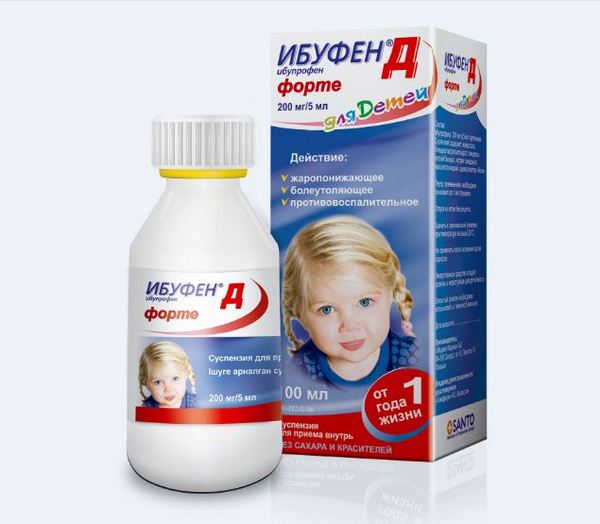
The baby’s body is not yet fully formed, so the use of medications can have a negative effect. If adverse reactions occur, you must stop using the drug and show the child to the pediatrician. It is prohibited to independently change the dosage and duration of the course. Drug therapy is prescribed by a doctor after examination.
If it is not possible to go to the hospital, you can use proven methods to reduce the temperature on your child:
- undress and wipe with a damp towel; give more fluid; wash in warm water.
It is advisable to reduce the temperature by 1-2 degrees. It is not at all necessary to strive to achieve the norm (36.6°). Excessive zeal can negatively affect the baby's health. Situations in which it is recommended to use antipyretic methods can be seen below:
- bad feeling; nervous state; insomnia; in the presence of neurological pathologies.
An ambulance will be called if there is a clear deterioration in the condition. This is evidenced by the following clinical picture:
- seizures occur; the temperature does not subside within 3 days; temperature 39 during teething and lack of effect from antipyretic medications; fever combined with diarrhea, vomiting and skin rash.
The arriving team of doctors will provide assistance to the baby and monitor his condition. In severe cases, hospitalization will be required.
Medicines prohibited for treating children
Many parents use medications from the first aid kit, relying on the instructions included in the kit. Often this is enough, but not in all cases. Some medications are contraindicated for treating children. Their list looks like this:
- "Aspirin" is created on the basis of acetylsalicylic acid. It is used as an antipyretic and analgesic. For children, Aspirin is strictly contraindicated, as it irritates the gastric mucosa and can cause Reye's syndrome. A complication of acute liver failure occurs. "Analgin" has an analgesic and antipyretic effect. The main active ingredient of the drug is metamizole sodium. Analgin is contraindicated for children due to its negative effect on the synthesis of blood cells. "Antipirin" is an antipyretic analgesic based on phenazone. The drug is contraindicated for children due to the high toxicity of the main active ingredient.
How to deal with a teething baby
When trying to help a teething baby, do not forget about your own mood. Children acutely feel the indignation and excitement of their parents. It is better to show the greatest possible care and patience, because during this period the baby needs special support. Try to distract him from unpleasant sensations with games and bright objects.
You should not lubricate your baby’s gums with alcohol-containing painkillers or give him an aspirin-based antipyretic. If your baby refuses to eat, refrigerate it until it is cool so it causes less discomfort.
Maximum temperature during eruption
If you are interested in what temperature is normal during teething and how much it can rise, then you need to consult a pediatrician. Each child has his own individual characteristics of the body, so answering the question is quite difficult. If you focus on statistics, then the average indicators do not exceed 37.7°. The maximum temperature allowed for the teething process is 38°.
A temperature exceeding 39° indicates the development of an infection in the body, which may occur during teething. Usually parents in this situation do not know what to do with themselves. Instead of panic, you must immediately call an ambulance and take measures to alleviate the child’s condition before it arrives.
Method number 3. Folk remedies
- If your child is not allergic to honey, you can lubricate your gums with this product. Then rub a small amount into the painful area. To calm down, give an additional 1 tsp before bedtime. honey
- A solution of soda (tsp per 200 ml of water) can also help teething: it is used to lubricate the gums, or used to moisten massage napkins.
- Massage the infant's gums with a piece of soft cloth moistened with cool water.
- Chamomile has a wide spectrum of action - it soothes, relieves inflammation, and relieves pain. Chamomile oil is rubbed into the skin of the cheeks, and the infusion is rubbed into the gums.
- Amber beads worn around the child's neck during the day relieve pain and reduce swelling. It is important to remember to take them off at night. Valerian tincture rubbed into a painful area temporarily anesthetizes and reduces irritability, maximum 5-7 drops per application.
- Soothing tea made from chamomile, lavender, lemon balm.
No less effective and popular are tinctures of sage, chickweed or burdock for strengthening gums and relieving pain, chicory or strawberry root, terry cloth and other folk remedies. Use cold vegetables and roots with caution. It is safer to replace them with teethers.
Proper nutrition of a child is another therapeutic component during teething: the diet should contain vitamins and calcium.
Read also: Details about folk remedies during teething
How long does the temperature last during teething in a child?
The most common complaint during teething is fever.
This is due to the natural inflammatory process that occurs in the gums.
Their swelling and redness are noted, and sometimes hematomas form due to strong pressure from the inside.
How many days does the temperature last during teething? This question worries every parent, because in addition to apathy, fever and tearfulness, the child may have loose stools, cough, and increased salivation. How to determine whether these symptoms are related to emerging teeth, or whether it is a developing cold?
What causes fever to rise during teething?
Contrary to the popular belief of parents, an increase in temperature on the teeth is not the norm and does not always accompany teething. In this way, the baby’s fragile body responds to the occurrence of an inflammatory reaction in the gum, through which the first tooth makes its way. In this place, immune defense is reduced, microorganisms living on the mucous membranes are activated - this also provokes temperature surges.
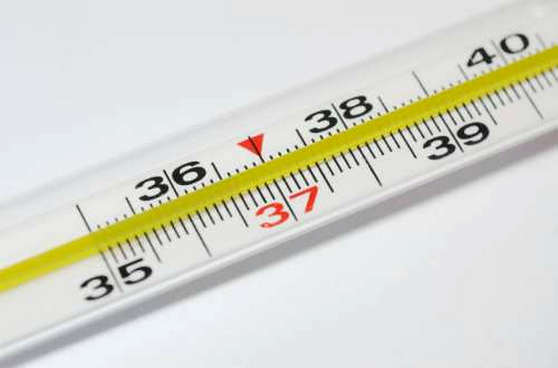
When teething, an increase in temperature to 38 degrees is not dangerous
This process is most difficult after a year, when fangs or molars are being cut, since the chewing teeth have several tubercles that cannot appear simultaneously and the process sometimes drags on for up to several weeks. The “eye” teeth are located slightly deeper than the others and must travel a longer path to the gum surface. Therefore, children usually experience quite severe discomfort and prolonged rises in temperature when they appear.
Sometimes fever during this period of life is a sign of an acute infection, which is due to reduced immunity. In this case, the body tries to protect itself from the invasion of viruses or bacteria and increases the temperature, which is destructive for pathogens.
Heat
The rudiments of teeth are formed in the prenatal period. By approximately the 20th week of pregnancy, the rudiments of baby teeth have already formed in the fetus and the formation of molars is actively underway. By 5–8 months the stage of eruption of the first tooth begins.
Teeth begin to grow from bone tissue, gradually making their way through the soft tissue of the gums.
This causes natural trauma to the gums, which leads to inflammation.
Infection occurs extremely rarely, because the process is internal, and only an open wound (if the edge of the tooth has already erupted) can cause infectious inflammation.
Normally, when teeth appear, the temperature does not rise above 37.5°C. The gums swell, swelling and hyperemia appear. The process is considered natural and lowering the temperature is not recommended. But during the period of teething, the baby’s general immunity is reduced, so parents need to carefully monitor the child’s well-being. It is likely that a cold will begin.
If the temperature rises above 38°C, then you need to follow a few simple rules:
Do not overheat the child. You should not wrap your baby up, especially if profuse sweating has begun. It is better to close windows and doors more tightly to prevent drafts. Dress the child in cotton underwear and change it as it gets wet. Do not bathe the child. You can come across advice about cool baths to relieve fever, but this is a very dangerous activity. It is better to apply a compress to your forehead. You can use a cabbage leaf or a napkin soaked in cool water. Provide plenty of fluids. The child's body reacts very sensitively to lack of fluid. If the temperature is high and there is not enough water to drink, the baby can quickly become dehydrated. Therefore, even with a slight increase in temperature, it is recommended to give the child plenty of water. Better with clean water; If the child is already 8 months old, you can prepare fruit drinks from black currants, lingonberries, and cranberries.
Temperatures above 38.5°C are considered high and dangerous for babies in their first year of life. At this time, the central nervous system is actively developing, and hyperthermia (high temperature) can cause disruption of the body’s normal reactions. This can lead to seizures, breathing problems and heart rhythm problems.
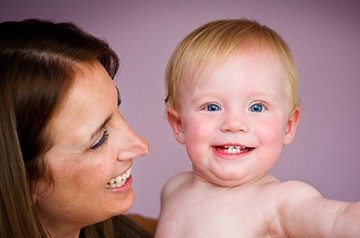
Normally, hyperthermia during the eruption of baby teeth lasts no more than 3 days.
The normal process is a gradual rise in temperature towards the night, from 36.6–37°C in the morning to 38.5°C in the evening. The sudden development of hyperthermia is very dangerous for the baby’s health.
If the temperature rapidly rises to 39°C or higher, you should consult a doctor. It is necessary to call a pediatrician at home, but if the fever rises at night, it is better to go to an ambulance.
A stable increase in temperature to 37.5°C and above is also dangerous. This indicates weak resistance of the immune system and exhaustion of the body. Stable hyperthermia is especially dangerous for children under one year of age. It can lead to a general disruption of thermoregulation. If the temperature does not drop to normal at all, then the reason is an active infection, and not teething.
If a child has a temperature above 38°C and refuses to eat or drink, then most likely this is not due to the appearance of teeth. It is worth contacting your pediatrician to rule out a serious illness.
Method number 5. Distractions
What else can you do to help your baby? If necessary, restructure yourself a little and change your principles. Don't you often pick up your little one? Imagine, carrying in your arms helps, the baby feels protected, so he calms down. Walk longer in the fresh air, feed not according to the clock, but according to the child’s demand (during this period, children are much more likely to latch on to the breast, while at the same time refusing complementary foods), prepare baths for him with the addition of chamomile (if there are no allergies!). If you use a pacifier, cool it often.
And lastly, do not disturb your baby during this period. He “knows” what he is doing. Pulls fists into mouth? Let be! Do not touch! “Scratching” your teeth with a toy – good for your health!
Remember: during the teething period, more attention should be paid to hygiene and cleanliness, since the child’s immunity decreases during this period and it is easy to catch an infection.
Advice for moms: be patient, because teething won't last forever, the first tiny tooth will appear very soon!
We also read:
- From how many months do the first teeth cut and in what order?
- Associated problems with teething
How long does it last?
Let's figure out how long the temperature lasts during teething. Normally, during teething, the fever rises for 1-3 days. This is the peak of the process, after which there is a decline. The temperature returns to normal, the gums stop hurting and itching, and the swelling subsides.
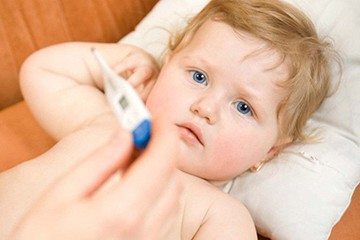
During the peak period, the child may be apathetic and lethargic. This is due to sore gums, which causes poor appetite.
With elevated body temperature, which makes the child lethargic. With general poor health: the baby begins to sulk and becomes whiny.
If a child is teething several times in a row, the fever may last longer – up to a week.
During this period, it is important to make sure that the fever is caused by teething. It is necessary to examine the child’s throat and pay attention to other symptoms that are characteristic of the appearance of baby teeth:
- increased salivation; swelling and redness of the gums; craving for chewing toys.
In order for the temperature to subside faster, it is necessary to speed up teething. There is no need to take drastic measures. It is enough to purchase a special teething toy. The toys are made of dense rubber, which allows the baby to “scratch his teeth” painlessly. You can give hard fruits or vegetables: carrots, apples.
Increased temperature during the appearance of teeth is an individual reaction of the body. Some children may have a fever for up to 5 days, and this is also considered normal. The main thing is to monitor how the temperature rises. After sleep it should be normal, increasing only in the evening. But if the temperature rises sharply, within a couple of hours, or does not subside for a long time, then this is a serious cause for concern for parents.

In older children, fever or other manifestations are rarely observed during the change of milk teeth to permanent ones.
Usually this process occurs painlessly and asymptomatically. But when wisdom teeth erupt, even an adult may have a fever.
If pericoronitis (inflammation of the gums above the wisdom tooth) has not developed, then the fever should not last long and usually does not rise above 37.5°C.
If your child has a fever, you should contact your pediatrician. You should not ignore the symptom, even if in the parents’ opinion it is associated with teething. Consulting a specialist is the best way to avoid complications.
Teething is an exciting stage for both baby and parents. When children cut their first teeth and how the baby behaves - read carefully.
How many teeth should an adult normally have? Read here.
A slight coating on a child’s tongue is normal. When can we talk about pathology? In this article https://zubki2.ru/detskaya-stomatologiya/polost-rta/belyj-nalet-na-yazyke-u-rebenka. html let's look at the pathological symptoms of a white film on the tongue.
What should parents pay attention to?
So, if a child begins to teethe, then the symptoms seem to be simple, which all mothers and fathers know.
But most pediatricians recommend that adults not ignore certain signs that accompany the process of growth of the first incisors. Sometimes stomach problems, nasal congestion or a cough in a child simply coincide with the time of teething, but are caused by slightly more serious reasons. In the first year of life, the baby’s body is just beginning to “ripen”; this is a rather difficult time when the child needs a lot of parental attention, careful attitude and care.
There is a very high risk of contracting some kind of infection , so adults need to clearly know and learn to identify the signs when a child begins to cut teeth, as well as symptoms of some disorders when you need to see a doctor.
The baby begins to cough
If a child begins teething, symptoms such as a slight cough due to excessive salivation are normal. This phenomenon occurs even more often if the baby is on his back. In this state, saliva enters the throat, and the normal cough reflex allows the baby to get rid of uncomfortable sensations. Do you cough less frequently when sitting? That is, everything is not so complicated and there is no danger. As a rule, this cough goes away on its own quite quickly.
When the cough is painful, wet, lasts for several days, wheezing is heard, the baby is choking, sputum production and shortness of breath - these are dangerous signs. You need to consult a doctor.
Rhinitis
Very often, adults, while children are teething, feel as if a common cold is going away. Simply, when teething, the amount of mucus in the nasal cavity increases. This condition does not directly pose any threat to the baby’s health. This runny nose most often ends within a couple of days. Moreover, the mucus that comes out of the nose is transparent and liquid. It is enough to periodically rinse the baby’s nasal cavity. In this case, no special treatment is needed.
In this case, severe nasal congestion and swelling, greenish or cloudy-white mucus requires special attention and urgent attention to a pediatrician. Especially when nasal congestion lasts more than one week.
Hyperthermia
When a baby begins to cut his first teeth, the signs are not always limited to just a runny nose or swollen gums. Sometimes there may be an increase in temperature .
This is explained by the active formation of bioactive substances in some areas of the gums. Most often this is a low-grade fever that lasts for several days. Then the child’s condition returns to normal. In certain situations, it is advisable to give the child an antipyretic. In those cases, if the temperature increases to 38 degrees or more, the baby is inactive, feels very unwell, and this condition continues for more than 2 days, then there is no need to postpone a trip to the pediatrician.
Diarrhea
During teething, as we have already said, salivation increases. The baby often swallows saliva, which speeds up gastrointestinal peristalsis . When adults see watery stools, they may rightfully be frightened, since diarrhea can quickly lead to dehydration, and this is a rather dangerous condition. But when a child rarely has bowel movements, and this diarrhea goes away within a few days, then there is simply no big reason for panic.
Seeing a doctor is only required if the diarrhea is frequent, intense, or if there is mucus or blood in the stool.
Approximate teething time
As a rule, the central incisors on the lower jaw grow no earlier than six months later, and on the upper jaw at the age of 7-12 months. Then comes the turn of the lateral incisors to grow. On the lower jaw, these teeth erupt at the age of 12-15 months, and on the upper jaw already at 15-16 months. Then the canines and first molars may begin to appear. The first appearance is observed in many children aged 1.5-2 years. The second molars on the lower jaw grow after 25 months and from 27 months on the upper jaw. Moreover, this time may vary, but approximately this occurs at the age of 2-3 years.
Often, the baby's first tooth begins to erupt when he or she is about 8 months . This slightly shifts the growth time of other teeth. Most often, before a child turns one year old, he has already grown one tooth. By the age of three, children usually have all 20 baby teeth.
Sometimes it happens that newborns' teeth appear in pairs. In some cases, you can observe 4 teeth breaking through at the same time. Naturally, this is a very large load for the child’s body, but this double teething is considered normal.
The most important thing to remember is that the growth time of the first molars, canines or incisors does not in any way affect the normal growth and development of children. Each child can go through certain stages of growing up, which are characteristic of his pace. This is absolutely no reason for adults to worry.
Caring for your baby during teething
Parents with babies under 1.5 years of age are advised to buy special silicone brushes for children .
This device makes it possible to gently and easily brush the very first teeth, which sometimes erupt at this age. When the baby is over 2 years old, you can buy a children's toothbrush. Then, when your child is over 3 years old, you can gradually teach him to rinse his mouth after eating. The initial years of a child's life are marked by increased emotional attachment to their mother. Therefore, if a child’s teeth begin to cut, gums swell and hurt, then it is better to try to give the baby maximum care and attention: calm the child with a lullaby, often carry the baby in your arms, distract him with some kind of toy.
When the process of growth of the first teeth occurs without complications, there is no need to treat the child very diligently, since this is an absolutely normal stage in the development of any baby.
Breastfed babies are advised to breastfeed if necessary. This will calm the baby and improve his sleep and well-being.
When teething, the baby's gums itch and swell. In order to alleviate this condition, reduce itching and pain, you need to give your child special teething toys. Today there is a huge selection of such devices. They are made from non-toxic and safe materials. Inside this “rattle”, as a rule, there is a special cooling gel or liquid that has an analgesic effect.
What temperature can you lower?
After consultation with a pediatrician, antipyretic drugs can be used to alleviate the child’s condition.
It is much more convenient for young children to give liquid forms of medicines rather than tablets:
It is recommended to reduce heat above 38.5°C. Up to this point, the body can cope on its own. If the temperature rises higher, then the child’s body needs help. Most modern antipyretic drugs, especially those labeled “for children,” also have an analgesic effect.
The most popular antipyretics:
- Paracetamol. It has antipyretic and slight analgesic effects. For children from 1 month of age, rectal suppositories are used. For children from 3 months - syrup. Preparations with paracetamol:
- Panadol; Cefekon D; Efferalgan; Paracetamol (syrup for children).
Ibuprofen. It has an anti-inflammatory effect, reduces fever, and is used as an analgesic. In syrup form, it is indicated for use from 6 months. Preparations with ibuprofen:
- Nurofen for children (from 3 months); Ibufen D; Advil for children; Ibuprofen (syrup for children from 6 months).
You should choose a drug to reduce fever after consulting a pediatrician and carefully studying the attached instructions. If it is not possible to use the drug in a convenient dosage form, then you can crush the tablet in a spoon, add water and give it to the child to drink. It is necessary to carefully look at the concentration of the active substance in one tablet and accurately calculate the required amount.
Sometimes an intramuscular injection of analgin and diphenhydramine is given to reduce the temperature. The amount of drugs is prescribed by the doctor, and the injection can be done independently, provided it is performed correctly. Typically, antipyretics in the form of injections are prescribed in hospitals; for home use, a convenient form of the substances described above is recommended. However, it is not recommended to give a child aspirin or analgin orally. These are aggressive drugs that negatively affect the gastrointestinal tract.
It is not recommended to lower the temperature below 38°C, because in this state the work of the immune system is activated.
To relieve the condition, you can use cooling wipes or compresses. In folk medicine there is advice about vodka (alcohol) and vinegar rubdowns on a child.
It is recommended to wipe the areas of large vessels - the armpit, inguinal folds, inner surfaces of the arms and thighs. These methods are considered ineffective and dangerous and are not recommended for children under 3 years of age. It is better to wipe the child with plain water, but only if the limbs are hot.
If the extremities are cold, but the temperature is high, then this is a sign of an increasing fever. Most likely the child has caught a cold and this has nothing to do with his teeth. In this case, it is not recommended to knock it down (up to 38.5°C), you should consult a doctor as soon as possible.
Even if a high temperature appears due to illness, you should not bring it down. 37–37.5°C is the temperature of “activation” of the immune system.
Every parent waits for their children to have teeth. When do babies cut their first teeth and in what order, we will tell you in detail. And also about what late eruption is.
We will discuss methods for getting rid of tartar at home or in dentistry below. From stone removal with citrus to ultrasound.
Method number 4. Medicines
Medicines that facilitate teething are divided into two types. The first are intended to relieve pain with the help of an anesthetic, which is part of the product. The latter have an anti-inflammatory effect.
If gels with an anesthetic are used, it is important not to exceed the dosage (2-3 mm of medication per application); they can only be used after consultation with a pediatrician who is monitoring the baby.
Anti-inflammatory agents are also available in the form of gels; they last quite a long time, so they are used no more than 2 times a day.
Homeopathic remedies are also used for teething. Many mothers note their effective effects. In addition to all the listed remedies, syrups are also used, which have a complex effect, improving the general condition of the little one.
List of medications:
- Kalgel (and its analogues Kamistad, Dentinox-gel, Dentol)
- Holisal
- Dantinorm
- Dentokind
- Nurofen
- Panadol
- Vibrukol
- Baby Doctor "First Teeth"
- Pansoral “First teeth”
We also read: First aid for teething in a baby: TOP - 7 gels for gums
We remind you once again: all medications can only be used with the permission of a doctor.
